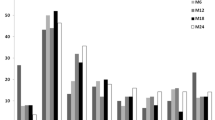Abstract
Neuromyelitis optica (NMO) is a life-threatening disease without any validated treatment strategy. Recent retrospective studies suggested the efficacy of B cell depletion without any distinction between first-line or rescue therapy. To assess whether rituximab as first-line therapy in NMO could efficiently control the occurrence of relapses. A retrospective analysis of NMO patients from NOMADMUS network found 32 patients receiving rituximab as first-line therapy. Main measures were number of relapse-free patients, changes in the annualized relapse rate (ARR), and changes in the EDSS. Tolerance was reported. At baseline, NMO patients were 45 ± 12.1 years old, with a sex ratio of 5.4, and 87.5 % of them had AQP4 antibodies. The median disease duration was 6.5 months (1–410), the mean EDSS was 5.8 ± 2.4 and the mean ARR was 3.8 ± 4.3. After rituximab with a mean follow-up of 28.7 ± 21 months, twenty-seven patients (84.3 %) were relapse free. Patients presented a 97 % decrease of ARR (p = 0.00001). EDSS decreased significantly to 3.9 ± 2.6 (p = 0.01). No relevant side effect was noted. New retrospective data are presented on RTX use in NMOSD. When used as first-line therapy RTX is highly effective and well tolerated.

Similar content being viewed by others
References
Kimbrough DJ, Fujihara K, Jacob A et al (2012) Treatment of neuromyelitis optica: review and recommendations. Mult Scler Relat Disord 1:180–187
Jacob A, Matiello M, Weinshenker BG et al (2009) Treatment of neuromyelitis optica with mycophenolate mofetil: retrospective analysis of 24 patients. Arch Neurol 66:1128–1133
Costanzi C, Matiello M, Lucchinetti CF et al (2011) Azathioprine: tolerability, efficacy, and predictors of benefit in neuromyelitis optica. Neurology 77:659–666
Jacob A, Weinshenker BG, Violich I et al (2008) Treatment of neuromyelitis optica with rituximab: retrospective analysis of 25 patients. Arch Neurol 65:1443–1448
Pellkofer HL, Krumbholz M, Berthele A et al (2011) Long-term follow-up of patients with neuromyelitis optica after repeated therapy with rituximab. Neurology 76:1310–1315
Cabre P, Olindo S, Marignier R et al (2013) Efficacy of mitoxantrone in neuromyelitis optica spectrum: clinical and neuroradiological study. J Neurol Neurosurg Psychiatry 84:511–516
Kim SH, Kim W, Li XF et al (2011) Repeated treatment with rituximab based on the assessment of peripheral circulating memory B cells in patients with relapsing neuromyelitis optica over 2 years. Arch Neurol 68:1412–1420
Kim SH, Huh SY, Lee SJ et al (2013) A 5-year follow-up of rituximab treatment in patients with neuromyelitis optica spectrum disorder. JAMA Neurol 70:1110–1117
Yang CS, Yang L, Li T et al (2013) Responsiveness to reduced dosage of rituximab in Chinese patients with neuromyelitis optica. Neurology 81:710–713
Ip VH, Lau AY, Au LW et al (2013) Rituximab reduces attacks in Chinese patients with neuromyelitis optica spectrum disorders. J Neurol Sci 324:38–39
Mealy MA, Wingerchuk DM, Palace J et al (2014) Comparison of relapse and treatment failure rates among patients with neuromyelitis optica: multicenter study of treatment efficacy. JAMA Neurol 71:324–330
Araki M, Matsuoka T, Miyamoto K et al (2014) Efficacy of the anti-IL-6 receptor antibody tocilizumab in neuromyelitis optica: a pilot study. Neurology 82:1302–1306
Krumbholz M, Meinl E (2014) B Cells in MS and NMO: pathogenesis and therapy. Semin Immunopathol 36(3):339–350
Wingerchuk DM, Lennon VA, Pittock SJ et al (2006) Revised diagnostic criteria for neuromyelitis optica. Neurology 66:1485–1489
Wingerchuk DM, Banwell B, Bennett JL et al (2015) International consensus diagnostic criteria for neuromyelitis optica spectrum disorders. Neurology, [Epub ahead of print]
Marignier R, Vukusic S, Collongues N, Zephir H, Papeix C, Audoin B, Laplaud D, Bourre B, Brochet B, Camdessanche JP, Labauge P, Moreau T, Stankoff B, De Seze J, Confavreux C, for the NOMADMUS study group and the Observatoire Français de la Sclérose En Plaques (OFSEP) (2013) Mycophenolate Mofetil as first line therapy in neuromyelitis optica spectrum disorder: retrospective multicenter study on 64 cases. Mult Scler 2013 19(Suppl 11):91–92
Kim SM, Park J, Kim SH et al (2013) Factors associated with the time to next attack in neuromyelitis optica: accelerated failure time models with random effects. PLoS One 16:e82325
van Vollenhoven RF, Emery P, Bingham CO 3rd et al (2013) Long-term safety of rituximab in rheumatoid arthritis: 9.5-year follow-up of the global clinical trial programme with a focus on adverse events of interest in RA patients. Ann Rheum Dis 72:1496–1502
Dass S, Rawstron AC, Vital EM et al (2008) Highly sensitive B cell analysis predicts response to rituximab therapy in rheumatoid arthritis. Arthritis Rheum 58:2993–2999
Acknowledgments
SFSEP: Société Francophone de la Sclérose en Plaques. NOMADMUS: groupe de travail sur la neuromyélite optique aiguë de Device. The authors are grateful to the members of the NOMADMUS group: Bruno Brochet, Philippe Cabre, Jean-Philippe Camdessanche, William Camu, Olivier Casez, Giovanni Castelnovo, Michel Clanet, Nicolas Collongues, François Cotton, Alain Creange, Gilles Defer, Jérôme de Seze, Marc Debouverie, Gilles Edan, Olivier Gout, Guillemette Jousserand, Philippe Kirschen, Pierre Labauge, David Laplaud, Thibault Moreau, Caroline Papeix, Jean Pelletier, Bruno Stankoff, Ayman Tourbah, Patrick Vermersch, Sandra Vukusic, and to the members of SFSEP group: Latif Al Kedhr, Olivier Anne, Eric Berger, Bruno Brochet, Philippe Cabre, Jean-Philippe Camdessanche, Olivier Casez, Marc Coustans, Alain Creange, Gilles Defer, Jérôme de Seze, Marc Debouverie, Nathalie Derache, Dominique Dive, Gilles Edan, Agnes Fromont, Riadh Gouider, Jérôme Grimaud, Arnaud Kwiatkowski, Olivier Heinzlef, Pierre Labauge, Emmanuelle le Page, Thibault Moreau, Caroline Papeix, Jean Pelletier, Pierrette Seeldrayers, Ilham Slassi Sennou, Bruno Stankoff, Ayman Tourbah, Frederic Thaite, Eric Thouvenot, Patrick Vermersch.
Author information
Authors and Affiliations
Corresponding author
Ethics declarations
Conflicts of interest
None of authors have conflict of interest with this study.
Additional information
On behalf of SFSEP and NOMADMUS.
Rights and permissions
About this article
Cite this article
Zéphir, H., Bernard-Valnet, R., Lebrun, C. et al. Rituximab as first-line therapy in neuromyelitis optica: efficiency and tolerability. J Neurol 262, 2329–2335 (2015). https://doi.org/10.1007/s00415-015-7852-y
Received:
Revised:
Accepted:
Published:
Issue Date:
DOI: https://doi.org/10.1007/s00415-015-7852-y




